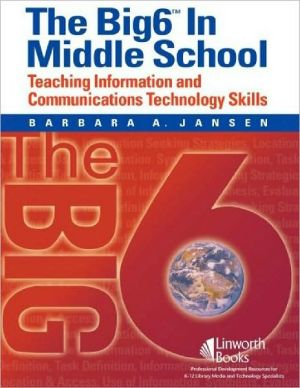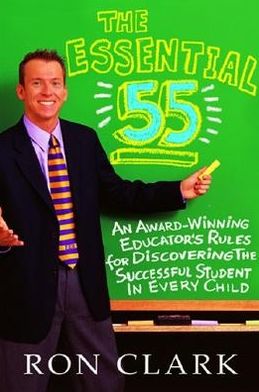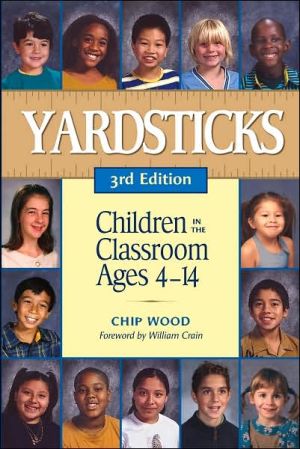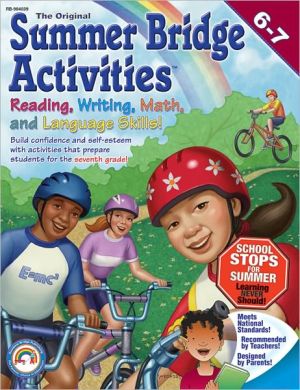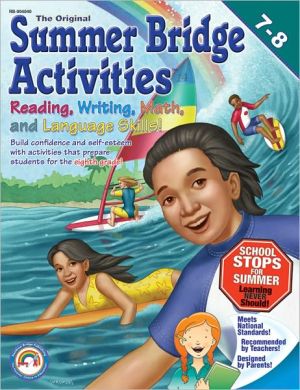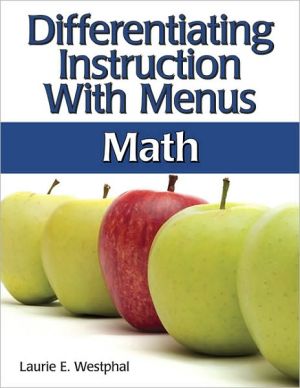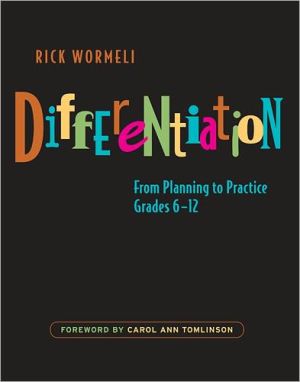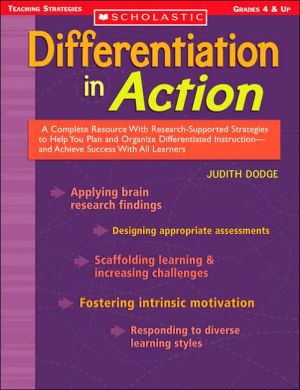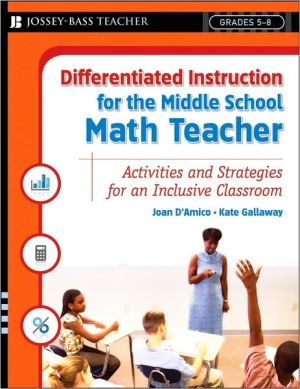The Big6 in Middle Schools: Teaching Information and Communications Technology Skills
This practical resource enables middle school educators—including classroom teachers, library media and technology specialists, and administrators—to understand and implement the Big6™ approach to information, communication, and technology skills learning. Written by long-time Big6™ consultant Barbara A. Jansen, and based on the Big6™ model developed by Michael B. Eisenberg and Robert E. Berkowitz, this book discusses specific techniques and strategies to embed the Big6™ into existing...
Search in google:
This practical resource enables middle school educators—including classroom teachers, library media and technology specialists, and administrators—to understand and implement the Big6ª approach to information, communication, and technology skills learning. Written by long-time Big6ª consultant Barbara A. Jansen, and based on the Big6ª model developed by Michael B. Eisenberg and Robert E. Berkowitz, this book discusses specific techniques and strategies to embed the Big6ª into existing instructional programs. Included are specific Big6ª instructional ideas in context, which can be used to modify and meet instruction needs. Jodi KearnsCopyright 2006 Reed Business Information. - School Library Journal Well articulated, with an obvious focus on currency of technology and research, this new volume in the Big6 dominion is updated and useful. Jansen states that the current problem in our society is information overload, and that learning and teaching with the Big6 research skills is the smart solution. The first part of this manual offers a modern reiteration of the original Big6 skills while addressing current trends in instructional technologies and media communications. The author encourages readers to remind themselves and students that all research is rooted in context, and to "anchor" themselves by keeping track of where they are within the process itself, and what the basic need (personal or curricular) is that led to implementing the Big6 skills. The second part of the book devotes one chapter to each of the Big6 steps and offers strategies for planning and instruction for each one. The third section provides several project organizers to copy for students as well as reproducibles to use as guides for collaboration, planning, and instruction. This is a huge resource that will be helpful to novices or to Big6 veterans who need a refresher.
Table of Figures ixAbout the Author xiAcknowledgments xiiPart I Michael B. Eisenberg Robert E. Berkowitz 1Chapter 1 Introduction-The Need and the Solution 3The Need-Living in an Information Society 3The Big6 5The Big6 and Other Approaches 5The Big6 and K-12 National Information Literacy Standards 6Higher Education 8Learning and Teaching the Big6 10Summary 11Works Cited 12Chapter 2 The Big6 Process and Skills 13Levels of the Big6 14Level 1 The Conceptual Level 14Level 2 The Big6 Skills 14Level 3 The 12 Sub-Skills of the Big6 15(1) Task Definition 16(2) Information Seeking Strategies 19(3) Location & Access 20(4) Use of Information 22(5) Synthesis 24(6) Evaluation 26Summary 28Chapter 3 Technology with a Big6 Face 29Introduction 29Technology and the Big6 30Examples of Technology in Big6 Contexts 32The Big6 and the Internet 33Summary 35Works Cited 36Chapter 4 Implementing the Big6: Context, Context, Context 39Introduction: Contexts 39Context 1 The Big6 Process 40Context 2 Curriculum 40Analyzing Curriculum from a Big6 Perspective 41Planning and Plans for the Individual Teacher 43Planning and Plans for a Subject Area, Grade, or Team 46Planning and Plans on the School Level 49Library Media Specialist as Big6 Coordinator 49Summary 51Chapter 5 Assessment of Information & Technology Skills 53Introduction 53Effectiveness and Efficiency 54Forms and Context for Assessment 55Ways of Assessing 56Evidence 56Content Learning Goals 58Big6 Learning Goals 58Criteria for Judging 58A Rating Scale for Judging 58The Judgments 58Big6 Scoring Guides59Self-Assessment 60Summary 63Part II Big6 in Action 67Introduction 67Chapter 6 Task Definition 69Get Started 69Introduce Task Definition to Students: Plan 69Identify the Content Objectives in Which Students Will Engage 69Big6 #1.1: Define the Problem-Create an Information Problem Based on the Content Objectives 70Higher-Level Thinking Considerations with Task Definition and Content Objectives 70Big6 #1.2: Identify the Information Needed-Decide What Information the Students Need to Have in Order to Do the Task 71Deliver Instruction 72Big6 #1.1: Define the Problem-Present the Information Problem to the Class 72Guide Students in Brainstorming the Task 72Big6 #1.2: Identify the Information Needed-Students Generate a List of Information Questions 72Discuss and Assign the Final Product 73Additional Examples of Information Problems from Other Subject Areas 73Additional Strategies for Engaging Students in Task Definition 75Show the Importance of the Task 75Develop Common Questions 75Identify Keywords 76Keyword Builder 77Group Work 77Individual Student-Selected Topics 78Use a Wiki to Organize and Present a Big6™<$$$>[Page No. 517] Project 80Wiki Task Definition Page 81Specific Uses of Technology 82Works Cited 82Chapter 7 Information Seeking Strategies 83Get Started 84Big6 #2.1: Determine All Possible Sources-Introduce Information Seeking Strategies to Students: Plan 84Deliver Instruction 84Big6 #2.1: Determine All Possible Sources and #2.2: Select the Best Sources 84Process of Exclusion-Brainstorming Sources of Information 85Additional Strategies for Engaging Students in Information Seeking Strategies 86Determine Types of Information Needed 86Identify the Best Sources for Specific Types of Information 89Demonstrate Subscription Services That Contain Multiple Databases 89Determine Content of Subscription Services and Databases 90Web Sites Included within Subscription Databases 90Evaluate Free Web Sites for Accuracy and Authority 90Web Evaluation for Young Learners in Grades Five and Six 91Web Evaluation for Grades Seven, Eight, and Nine 92Use a Wiki to Support Information Seeking Strategies 93Specific Uses of Technology for Information Seeking Strategies 94Works Cited 94Chapter 8 Location and Access 95Get Started 96Introduce Location and Access to Students: Plan 96Big6 #3.1: Locate Sources 96Big6 #3.2: Accessing Information within Sources 97Big6 #3.1 and #3.2-Deliver Instruction 98Additional Strategies for Engaging Students in Location and Access 98Teach the Concept of Indexing 98Use Boolean Operators 98Search the School Library's Catalog 100Search Within a Subscription Database 100Print Articles from Databases 102Use Advanced Search Strategies for Google™<$$$>[Page No. 517] and Other Search Engines 102Use a Wiki to Support Location and Access 102Specific Uses of Technology to Support Location and Access 103Work Cited 104Chapter 9 Use of Information 105Get Started 106Introduce Use of Information to Students: Plan 106Big6 #4.1: Engage in the Source 106Big6 #4.2: Extract Relevant Information 106Deliver Instruction 106Big6 #4.1: Engage in the Source 106Skimming 107Scanning 107Big6 #4.2: Extract Relevant Information-Note Taking 108Citing Sources 108Additional Strategies for Engaging Students in Use of Information 108Note Taking 108Trash and Treasure note taking Method 109Summarize Information 110Paraphrase Information 110Reinforce Summarizing and Paraphrasing 111Compare Information from More Than One Source 111Consider Electronic Note Taking 112Use Note Taking Organizers 112Data Chart 113Note Taking Form Created with Word Processor 115Use PowerPoint for Recording Notes 116Note Taking from Other Sources 120Use a Wiki to Support Use of Information 120Specific Uses of Technology for Use of Information 121Works Cited 122Chapter 10 Synthesis 123Go Beyond the Facts 124Learn Transferable Skills 124Provide an Audience 125Get Started 125Introduce Synthesis to Students: Plan 125Big6 #5.1: Organize Information from Multiple Sources 126Big6 #5.2: Present the Result 126Deliver Instruction 126Additional Strategies for Engaging Students in Synthesis 127Copyright 127Teach Students to Avoid Plagiarism 127Practice Tested Reading and Writing Skills 128Include an About the Author Section 128Create Original Illustrations 128Think Before Using PowerPoint as Presentation Tool 130PowerPoint Slide Show Guidelines for Students 133Use a Wiki to Support Synthesis 133Specific Uses of Technology to Support Synthesis 134Chapter 11 Evaluation 135Evaluate Process and Product 135Formal Self-Evaluation Guide 136Informal Self-Evaluation Guide 136Give Students Early Access to Self-Evaluation Guides 137Get Started 138Introduce Evaluation Strategies to Students: Plan 138Big6 #6.1: Judge the Result and Big6 #6.2: Judge the Process 138Deliver Instruction 138Formal Self-Evaluation Guide 138Informal Self-Evaluation Guide 138Additional Strategies for Engaging Students in Evaluation 139Evaluate Progress 139Peer Evaluation 141Use a Wiki to Support Evaluation 141Specific Uses of Technology to Support Evaluation 142Examples of Content Checklists 142Chapter 12 Putting It All Together 149Correlating the Big6 to State Curriculum Standards and Tested Skills 149Integrate the Big6 in Content Areas: Lesson Plans 156Lesson Plan: Writing Historical Fiction 157Grade: Five 157Lesson Plan: The Student Council's Math Problems 160Grade: Six 160Lesson Plan: State Historical Figures Write Journals and Letters 162Grade: Seven 162Lesson Plan: Think Globally, Act Locally: Reduce, Recycle, and Reuse! 165Grade: Eight 165Lesson Plan: You've Been Hired by BHO: Ancient Rome! 168Grade: Nine 168Pathfinders 172Part III Big6 Cool Tools 178Assignment Organizer for Grades 5-6 179Assignment Organizer for Grades 7-9 181Writing Process Organizer for Grades 5-6 183Writing Process Organizer for Grades 7-9 187History Fair Process Organizer 191Science Fair Project Organizer 195Presentation Guidelines for Middle School 200Instructional Unit Planning Guide 204Explanation for Evaluating Big6 Units of Instruction 208Checklist for Evaluating Big6 Units of Instruction 210Big6 Steps to Teacher and Librarian Collaboration 213Big6 Strategies for Computer Collaboration 214Big6 in Six Minutes: Planning for Faculty Inservice 215Index 223
\ From the Publisher"Well articulated, with an obvious focus on currency of technology and research, this new volume in the Big6 dominion is updated and useful. Jansen states that the current problem in our society is information overload, and that learning and teaching with the Big6 research skills is the smart solution. The first part of this manual offers a modern reiteration of the original Big6 skills while addressing current trends in instructional technologies and media communications. The author encourages readers to remind themselves and students that all research is rooted in context, and to 'anchor' themselves by keeping track of where they are within the process itself, and what the basic need (personal or curricular) is that led to implementing the Big6 skills. The second part of the book devotes one chapter to each of the Big6 steps and offers strategies for planning and instruction for each one. The third section provides several project organizers to copy for students as well as reproducibles to use as guides for collaboration, planning, and instruction. This is a huge resource that will be helpful to novices or to Big6 veterans who need a refresher."\ -\ School Library Journal\ "Jansen (U. of Texas at Austin School of Information) is a consultant in the Big6 method for teaching information and technology skills. In this book, she offers advice specific to 5th-9th grade classrooms and libraries. Readers will learn how to teach the method that organizes research and technology projects into six steps: task definition, information seeking strategies, location and access of information, use of information, synthesis, and evaluation. Charts help teachers gauge the correlation between their state's standards for tested skills and skills developed in Big6 projects, and example lesson plans and handouts are included. The included CD-ROM contains information from the text."\ -\ Reference & Research Book News\ \ \ \ \ \ School Library JournalWell articulated, with an obvious focus on currency of technology and research, this new volume in the Big6 dominion is updated and useful. Jansen states that the current problem in our society is information overload, and that learning and teaching with the Big6 research skills is the smart solution. The first part of this manual offers a modern reiteration of the original Big6 skills while addressing current trends in instructional technologies and media communications. The author encourages readers to remind themselves and students that all research is rooted in context, and to "anchor" themselves by keeping track of where they are within the process itself, and what the basic need (personal or curricular) is that led to implementing the Big6 skills. The second part of the book devotes one chapter to each of the Big6 steps and offers strategies for planning and instruction for each one. The third section provides several project organizers to copy for students as well as reproducibles to use as guides for collaboration, planning, and instruction. This is a huge resource that will be helpful to novices or to Big6 veterans who need a refresher.\ —Jodi KearnsCopyright 2006 Reed Business Information.\ \ \
